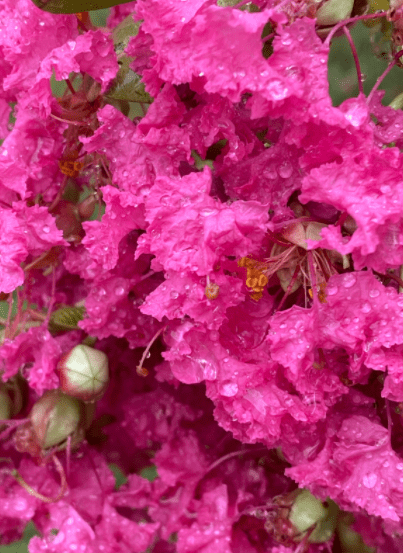Crepe Myrtles
Crepe myrtles, which are native to East Asia, can grow in almost any climate. Crepe myrtles are frost-tolerant, but they can also tolerate heat and are drought-tolerant once established.
They are known for their delicate, delicate, crepe-like crinkly blossoms. They are found at the tips and can come in various colors, including whites, pinks, purples, reds, mauves, purples, and reds.
The last two to three months, and new buds will grow if you remove the spent flowers promptly.
There are many types of crepe myrtle. They range from groundcovers to shrubs to trees up to six meters in height. The Indian Summer range was specially bred to resist powdery mold.
They are bred from Lagerstroemia Indica and Lagerstroemia Fauriei, which are less common.
They come in a variety of sizes, ranging from 3m to 6m. Each one is named after an American Indian tribe Acoma, which has white flowers, grows to 3m tall, while Natchez, the other white, grows to 6m.
Yuma, Tonto, and Sioux are pink shades that grow 3-4m high. Biloxi, a pinker variety that grows to 7m tall, is the tallest. Tuscarora, which is rose-red, grows up to 6m. Zuni is also available in mauve and can grow to 3m.
Crepe Myrtle Care
Crepe myrtles may be the victims of runaway clippers and chain saws trying to clean up devastating landscapes quickly. I consistently remind people to mimic nature. Crepe myrtles are understory trees and should be trimmed like trees.
Removing all branches to the trunk or sizeable primary branch stubs is not recommended for other trees, so don’t force inappropriate pruning techniques on crepe myrtles. Topping of crepe myrtles and other trees used to be common practice until research showed the negative impacts.
Rapid growth typically follows severe pruning. Crepe myrtles react this way, providing a quick flush of new branches and subsequent flowering. This growth is not healthy but a survival response to the devastation. Crepe myrtles try to replace leaves needed for photosynthesis quickly.
Size control may be justified. However, crepe myrtles come in sizes from 3 to 25 feet. Pruners aren’t needed to keep them in check. If the crepe myrtle overgrows the space every year, then it is planted in the wrong place.
Remove the tree and replant it with a smaller variety or a different plant that will mature at the desired size.
Pruning Issues
After excessive pruning, the new branches aren’t strong. They can easily snap in high winds. The larger the knot they emerge from, the weaker they are attached. Unsightly gnarls appear at the cut site if plants are pruned back to the same place annually.
Multiple branch collars fuse, trying to seal the damage caused by excessive pruning. Although gnarls might not be readily apparent in summer, these ugly gnarled branch stubs are the focal point until growth returns.

The plant’s life expectancy may be reduced, too, as it becomes weaker over time from being forced into survival mode annually. Dormant crepe myrtles often have seed pods still attached to branch tips.
If you don’t like the look, clip the branches’ tips back a couple of inches until you have a cleaner look. If you have gnarls that you want to remove, the only option is to cut below the swollen area one final time and allow branches to grow.
Select the largest one or two this year and protect and train their growth to produce healthier growth.
Crepe Myrtle Winter Care
To ensure crepe myrtle survives the winter in Western regions, locate it in a sheltered spot, perhaps between two buildings or in a corner where it’s protected from strong winter winds. Proper drainage is essential to winter survival as crepe myrtles resent water-logged soil around their roots.
To adequately protect your crepe myrtle, wrap the plant with a layer of insulation. This can be accomplished by creating an open-topped, cylindrical wire cage around the plant using chicken wire or box wire fencing.
Be sure the cage is a foot or two more significant than the shrub is in diameter. The cell should also be about a foot higher than the top of the plant. If your shrub is very tall, you may want to prune the plant back by half of its height to make the cage a more manageable size.
Once the cage is over the plant, use landscape pins to secure it to the soil, then fill the cell with straw or shredded leaves until the entire shrub is covered and well-insulated.
Since crepe myrtles bloom on new wood, you’ll need to do any pruning in fall, winter, or very early spring. I find the excellent time to prune my crepe myrtle is during the springtime, immediately after I remove the cage and straw at the beginning of April.
Doing so allows the plant to have enough time to develop new growth and flower buds by mid-summer.
Another shrub this technique works quite well on is mop-head hydrangeas (Hydrangea macrophylla). With this shrub, the buds form on old wood. It’s essential to protect the stems through the winter as they house next year’s developing flowers.
The most common reason hydrangeas fail to bloom is because the unprotected buds do not survive the winter and freeze out. Insulating them with a wire cage filled with straw is very effective.























